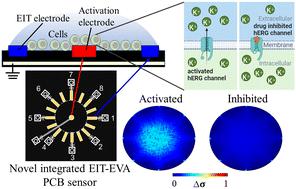Our official English website, www.x-mol.net, welcomes your feedback! (Note: you will need to create a separate account there.)
Non-invasive hERG channel screening based on electrical impedance tomography and extracellular voltage activation (EIT–EVA)
Lab on a Chip ( IF 6.1 ) Pub Date : 2024-05-23 , DOI: 10.1039/d4lc00230j Muhammad Fathul Ihsan 1 , Daisuke Kawashima 2, 3 , Songshi Li 2 , Satoshi Ogasawara 4, 5 , Takeshi Murata 4, 5 , Masahiro Takei 2
Lab on a Chip ( IF 6.1 ) Pub Date : 2024-05-23 , DOI: 10.1039/d4lc00230j Muhammad Fathul Ihsan 1 , Daisuke Kawashima 2, 3 , Songshi Li 2 , Satoshi Ogasawara 4, 5 , Takeshi Murata 4, 5 , Masahiro Takei 2
Affiliation

|
hERG channel screening has been achieved based on electrical impedance tomography and extracellular voltage activation (EIT–EVA) to improve the non-invasive aspect of drug discovery. EIT–EVA screens hERG channels by considering the change in extracellular ion concentration which modifies the extracellular resistance in cell suspension. The rate of ion passing in cell suspension is calculated from the extracellular resistance Rex, which is obtained from the EIT measurement at a frequency of 500 kHz. In the experiment, non-invasive screening is applied by a novel integrated EIT–EVA printed circuit board (PCB) sensor to human embryonic kidney (HEK) 293 cells transfected with the human ether-a-go-go-related gene (hERG) ion channel, while the E-4031 antiarrhythmic drug is used for hERG channel inhibition. The extracellular resistance Rex of the HEK 293 cells suspension is measured by EIT as the hERG channels are activated by EVA over time. The Rex is reconstructed into extracellular conductivity distribution change Δσ to reflect the extracellular K+ ion concentration change Δc resulting from the activated hERG channel. Δc is increased rapidly during the hERG channel non-inhibition state while Δc is increased slower with increasing drug concentration cd. In order to evaluate the EIT–EVA system, the inhibitory ratio index (IR) was calculated based on the rate of Δc over time. Half-maximal inhibitory concentration (IC50) of 2.7 nM is obtained from the cd and IR dose–response relationship. The IR from EIT–EVA is compared with the results from the patch-clamp method, which gives R2 of 0.85. In conclusion, EIT–EVA is successfully applied to non-invasive hERG channel screening.
中文翻译:

基于电阻抗断层扫描和细胞外电压激活的非侵入性 hERG 通道筛查(EIT-EVA)
基于电阻抗断层扫描和细胞外电压激活 (EIT-EVA) 的 hERG 通道筛选已实现,以提高药物发现的非侵入性。 EIT-EVA 通过考虑细胞外离子浓度的变化来筛选 hERG 通道,从而改变细胞悬浮液中的细胞外电阻。离子在细胞悬浮液中通过的速率根据细胞外电阻R ex 计算,该电阻是通过在500kHz频率下的EIT测量获得的。在实验中,通过新型集成 EIT-EVA 印刷电路板 (PCB) 传感器对转染人 ether-a-go-go 相关基因 (hERG) 的人胚胎肾 (HEK) 293 细胞进行非侵入性筛选离子通道,而E-4031抗心律失常药物用于hERG通道抑制。当 EVA 随着时间的推移 hERG 通道被激活时,通过 EIT 测量 HEK 293 细胞悬浮液的细胞外电阻 R ex 。将R ex 重构为细胞外电导率分布变化Δσ,以反映hERG通道激活引起的细胞外K + 离子浓度变化Δc。在hERG通道非抑制状态期间Δc快速增加,而随着药物浓度c d 的增加,Δc增加较慢。为了评估 EIT-EVA 系统,根据 Δc 随时间变化的速率计算抑制比指数 (IR)。从 c d 和 IR 剂量反应关系中获得 2.7 nM 的半最大抑制浓度 (IC 50 )。将 EIT-EVA 的 IR 与膜片钳方法的结果进行比较,得出 R 2 为 0.85。总之,EIT-EVA 已成功应用于无创 hERG 通道筛查。
更新日期:2024-05-23
中文翻译:

基于电阻抗断层扫描和细胞外电压激活的非侵入性 hERG 通道筛查(EIT-EVA)
基于电阻抗断层扫描和细胞外电压激活 (EIT-EVA) 的 hERG 通道筛选已实现,以提高药物发现的非侵入性。 EIT-EVA 通过考虑细胞外离子浓度的变化来筛选 hERG 通道,从而改变细胞悬浮液中的细胞外电阻。离子在细胞悬浮液中通过的速率根据细胞外电阻R ex 计算,该电阻是通过在500kHz频率下的EIT测量获得的。在实验中,通过新型集成 EIT-EVA 印刷电路板 (PCB) 传感器对转染人 ether-a-go-go 相关基因 (hERG) 的人胚胎肾 (HEK) 293 细胞进行非侵入性筛选离子通道,而E-4031抗心律失常药物用于hERG通道抑制。当 EVA 随着时间的推移 hERG 通道被激活时,通过 EIT 测量 HEK 293 细胞悬浮液的细胞外电阻 R ex 。将R ex 重构为细胞外电导率分布变化Δσ,以反映hERG通道激活引起的细胞外K + 离子浓度变化Δc。在hERG通道非抑制状态期间Δc快速增加,而随着药物浓度c d 的增加,Δc增加较慢。为了评估 EIT-EVA 系统,根据 Δc 随时间变化的速率计算抑制比指数 (IR)。从 c d 和 IR 剂量反应关系中获得 2.7 nM 的半最大抑制浓度 (IC 50 )。将 EIT-EVA 的 IR 与膜片钳方法的结果进行比较,得出 R 2 为 0.85。总之,EIT-EVA 已成功应用于无创 hERG 通道筛查。












































 京公网安备 11010802027423号
京公网安备 11010802027423号